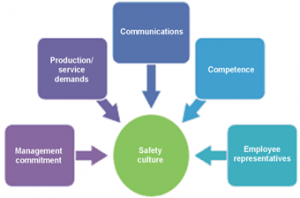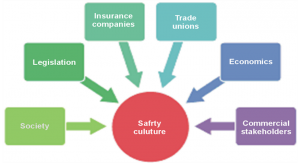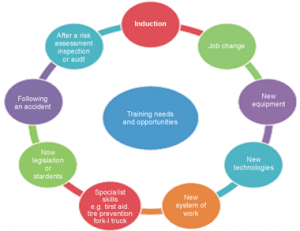Introduction
According to research by the International Labour Organization (ILO 2019), every year, 2.34 million people die due to occupational fatalities, 2.02 million of which were from work-related accidents and incidents. This is equivalent to about 5,500 deaths every day. This causes huge sufferings for workers and their families as well as serious economic losses for industries and societies. However, many of these tragedies are preventable through the implementation of sound measures, information and training, adequate inspection and the commitment of governments, employers and workers to occupational safety and health.
Some of the major findings in the International Labour Organisation’s (ILO 2019) statistical data include the following:
- The construction industry has a disproportionately higher rate of recorded accidents.
- The ageing population in developed countries means that an increasing number of older persons are working and need special consideration. This also puts young and new employees in a vulnerable position.
The rate of fatal accidents in a developing country like Malaysia is four times higher than in industrialised countries such as the United Kingdom and United States. This is because, most work-related accidents occur in primary industries in the country, like farming, fishing and logging, mining and construction, due to low literacy and poor training in safety methods in these sectors.
Occupational Safety & Health (OSH) issues are paramount as they form an important part of the ILO’s agenda. Nevertheless, the Conference in 2019 discussed OSH standards as part of an integrated approach and reached an agreement to reduce the number of work-related deaths and injuries through a global OSH strategy that calls for “coherent and focused” action.
Following this, the ILO has called on its members to participate in joint efforts to improve the safety of workers. It is very clear that the introduction of a systematic approach to OSH management based on the global OSH strategy is needed. This needs to be complemented by a strong generative safety and health culture in all enterprises. Both have been included in the ILO Guidelines on Occupational Safety and Health Management Systems (ILO-OSH-MS 2001) for global industries to adopt and implement.
One of the factors that contributed to accident rates at workplace is the lack of safety culture in the organisations. This article will discuss this in greater detail.
The Concept of Safety Culture
Rubin et al. (2019) defined Safety Culture as ‘the set of belief, norms, attitudes, roles, as well as social and technical practices that are concerned with minimising the exposure of employees, managers, customers and members of the public to conditions considered dangerous or injurious’. The Confederation of British Industry (CBI) defined it as ‘the ideas and beliefs that all members of the organisation share about risks, accidents and ill health.’
The Advisory Committee for Safety in Nuclear Installations (ACSNI) defined it as ‘the product of individual and group values, attitudes, competencies and pattern of behaviour that determine the commitment to and the style and proficiency of an organisation’s safety and health programmes.’ This definition was subsequently adopted by the U.K. Health and Safety Commission (HSC) in 1993.
The safety culture of an organisation is the product of individual and group values, attitudes, perceptions, competencies, and patterns of behaviour that determine the commitment to and the style and proficiency of an organisation to health and safety management. Organisations with a positive safety culture are characterised by communications founded on mutual trust, shaped by shared perceptions of the importance of safety and confidence in the efficacy of preventive measures (ACSNI, 1993).
Culture is understood as a system of common symbols and the common meanings connected to these symbols. This does not mean that people agree on what is right, wrong, smart, or stupid (Freilich, 1973). Instead, the work, problem-solving, and coordinating of people and contractors will be of special concern to organisations.
Building a safety culture also means negotiations, use of power and the capability of someone more than others to convince people in some direction while making their own opinions sound (Bourdieu, 1991).
Internal and External Factors Influence Safety Culture
Internal and external influences are factors that can affect the initiation and implementation of safety culture. These can be both, positive and negative in nature.
Internal influences Internal influences can include the management’s commitment, production or service demands, communications, competence, and employee representatives as shown in Figure 1 below.
According to Harris (2002), management commitment indicates the capability of senior managers of the company to provide an appealing message to the workforce about safety issues. As such, in order to demonstrate to employees what they actually want to achieve, senior managers and other authoritative figures within the company should attain a desired level of performance of safety issues. If the employees found out that senior managers and directors have ignored or discarded safety policies and its concerns, employees will develop a negative perception about the safety policies that they are implementing.
The management’s commitment is portrayed when senior managers conduct regular safety inspections and meetings with health and safety committees and those involved in seriously solving cases of hazards and accidents. Production or service demands reflect the company’s obligations to establish a balance between customers’ demands and employees’ actions. The instructions by senior authorities may create a dilemma for employees on whether they should ignore factors that may pose a danger to their lives when fulfilling customer demands. This is especially the case when there is the perception that employees must meet customer demands at all costs.
Thus, there is an obligation on the part of organisation to save employees and customers from such a dilemma. At the same time, employees should also be guided and instructed to make sensible and reasonable decisions when undertaking their priorities (Harris, 2002).

Figure 1: Internal influences on safety culture (Source: Harris 2002).
According to Bohle & Quinlan (2000), poor communication often creates confusion and conflict among organisation’s personnel. There is also the possibility that safety and health procedures are often misunderstood and not followed by staff members because the procedures were poorly communicated to them. Left unaddressed, misunderstanding and a lackadaisical attitude towards safety and health can cause accidents and serious injuries of staff members.
Therefore, it is necessary for senior managers to conduct regular discussions with staff members to establish proper policies and put implementation procedures in place. This approach will enable them to identify problems and issues at the earliest possible level and recommend suitable solutions accordingly (Bohle & Quinlan, 2000).
Competence is another significant internal influence that deals with knowing and understanding what the organisation’s members are doing and the skills needed to make them more effective. Boyd (2003) has also stated that this internal influence can play a surprising role in ensuring organisational adherence to established health and safety policies and procedures. For example, competence cannot be brought in from the outside. On the contrary, it needed to be developed and nurtured amongst internal team members.
Therefore, employees and staff members should be provided with the opportunity to interact and converse with senior authorities on a regular basis. Such conversations and interactions will enable workers and staff members to recognise their mistakes, learn new lessons and make positive changes in their organisation.
The concept of safety and health culture is an enduring one. It demands constant learning and commitment from all parties involved. Therefore, organisations can make this happen by strengthening their internal competence. One of the most significant internal influences that organisations need to deal with regularly is employee representation. Companies need to make employees enthusiastic and competent, in order to succeed in their implementation of health and safety standards. Furthermore, employees will be more willing to implement these measures properly if they are consulted in the development and feel involved in the entire process.
External influences
However, in order to make safety and health culture more adaptive and flexible, there are also various external influences that organisations need to take into consideration. These may include trade unions, societal expectations, economic conditions, stakeholders demands, as well as legislations and enforcements.
This is seen in Figure 2 below.

Figure 2: External influences on safety culture (Source: Creighton & Rozen 2007).
Elements of Safety Culture
The safety culture that is based on societal expectations is a highly variable term and tend to change with time and situation. Societal expectations differ significantly between one country to the next. For example, societal expectations are considered low in underdeveloped and poor countries and high in developed and wealthy nations.
The standards of safety culture have increased significantly in the UK over the last 10 years. A report presented by (Karmis, 2001) highlighted that the demand for cars have increased tremendously in UK at the start of the 21st century. With that increase comes customer expectations for safe, comfortable, advanced and customisable automobile products and services.
The demands for high standards of safety for employees has led to better safety culture in organisations. The intrinsic link between societal expectations and workplace safety standards is apparent in most organisations and industries.
Businesses operate in a dimension that consist of varying sets of internal and external stakeholders. Internal stakeholders comprise employees, management team, directors and more while external stakeholders include suppliers, the government, investors, and the likes.
Internal and external stakeholders are not only concerned with business sustainability but also profitability. It has been found that businesses with a higher orientation towards health and safety enjoy better relationship with stakeholders. Moreover, investors and suppliers that adhere strictly to their own health and safety measures are more interested in working with organisations that place a premium on high standards of health and safety.
Therefore, in implementing a health and safety culture, it is necessary for organisations to consider the influence and role of stakeholders (Cahill & Kane, 2010). One of the major external influences regulating employees and their working behaviour is trade unions. Trade unions do not only protect employees, but they also influence HR policies and legislations. In most industries, trade unions have played a significant role in demanding the implementation of stringent health and safety standards for employees.

Figure 3: Different Levels of Safety Culture in Organizations (Source: Bergersen 2003, p.14).
Training Programmes on Safety Culture
According to Bonehill (2011), employee awareness and understanding of health and safety issues is highly dependent the training that they receive. Therefore, it is the organisation’s responsibility to provide the right training and information that can enhance such awareness and understanding amongst its members.
This is particularly the case when it comes to the risks and dangers associated with their assigned tasks and responsibilities. Furthermore, such training and information sharing can also empower employees to think about and adopt mitigating and preventative measures that are necessary to making their jobs safer.
Bonehill (2011) also stated that today, businesses have a legal obligation to conduct safety training programmes that adhere to industry standards and practices. Beyond industry adherence, these training programmes also yield various direct and indirect business benefits. These may include reduction in harm and risks, as well as compensation and absenteeism. It could also lead to improvement in employee motivation, morale and overall working experience.
According to Karmis (2001), health and safety training programmes must be delivered based on the needs of the business and employees. For example, newly hired employees or those who have been transferred to a new department or environment will require training or retraining on health and safety procedures that are aligned to their new roles and responsibilities.
This is confirmed by Boyd (2003), which stated that the need for training programmes increases when an employee is transferred or introduced to new job environment. Thus, it is necessary for organisations to provide training to employees to fulfil their new set of responsibilities in an effective manner
Beyond new roles and employees, other instances that require training on health and safety include changes in working pattern and employment status, adopting a new set of technologies and vulnerabilities in the working environment (Boyd 2003).
According to Collins (2009), while the task of developing health and safety procedures is often placed in the hands of senior management, sound and effective leadership is required to ensure that such procedures are not only adopted by employees at every level but also become a strong part of the organisation’s safety culture in the long run.

Figure 4. Training needs and opportunities (Source: Karmis 2001).
All workers need training to perform their jobs well. New workers need the induction programme to familiarise themselves with the workplace environment. Existing workers on the other hand, need training when they need to use new equipment, technologies or systems to perform their jobs. Others will require specialised or niche training that may or may not be related to their particular roles or functions. For example, first aid training that not only cuts across roles and responsibilities but is also one of the most necessary skills for employees to have in keeping their work environment safe and healthy.
Trainings are not only necessary for preventative measures, but also for post-accident-related matters. Organisations often conduct investigations into work accidents. These investigations are usually performed by employees, and they too require training on how to conduct such investigations effectively, to identify the exact problem and find a long-term viable solution that prevents reoccurrence.
Conclusion and the Way Forward
In order to ensure the effective and successful implementation of health and safety standards, organisations must cultivate a strong and generative safety and health culture. This must be done through a long-term visionary approach and complemented by regular assessments of the safety and health status of the organisation to identify areas of improvements and develop necessary recommendations.
An effective leadership is important in strengthening employee commitment to safety and health. To be effective, leaders must communicate the company’s safety and health policies clearly, while ensuring that all procedures and processes are easy to understand and follow. This must be complemented by the company’s investment into financial, technological, and human resources that will equip employees in adhering to such safety and health processes. By taking this complete and holistic approach to safety and health, organisations can ensure that they not only have a solid culture in place, but they can also really see the tangible positive impact of having safe, healthy, happy, and productive employees in the long term.
The author would like to thanks to Mr Alex Kelling Anak Buja, Doctor of Business Administration (DBA) scholar at the Malaysian Graduate School of Entrepreneurship & Business (MGSEB), Universiti Malaysia Kelantan (UMK) who assisted in this research project.
Professor Dr. Balakrishnan Parasuraman is a Professor of Management/ HR/ Industrial Relations at the Faculty of Entrepreneurship and Business, Universiti Malaysia Kelantan (UMK) based in Kota Bahru, Kelantan. He is a research fellow of the National Human Resource Centre (NHRC) of HRD Corp. The writer wishes to acknowledge Mr Firdaus Nizam for assisting in this research.
The views expressed here are entirely the writer’s own.



